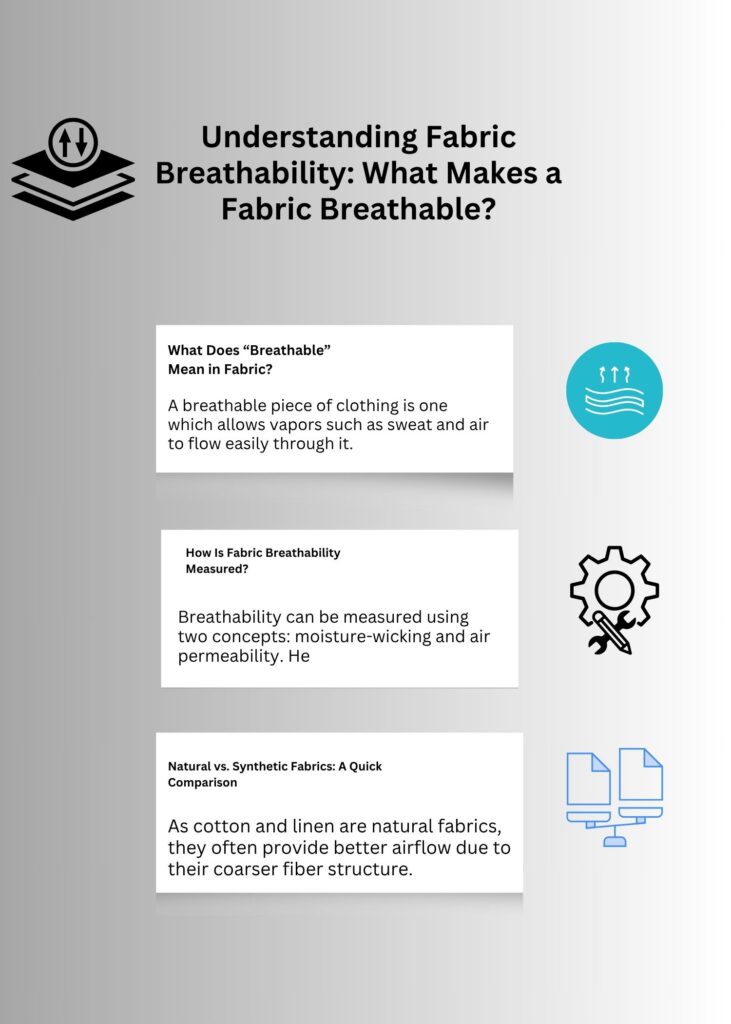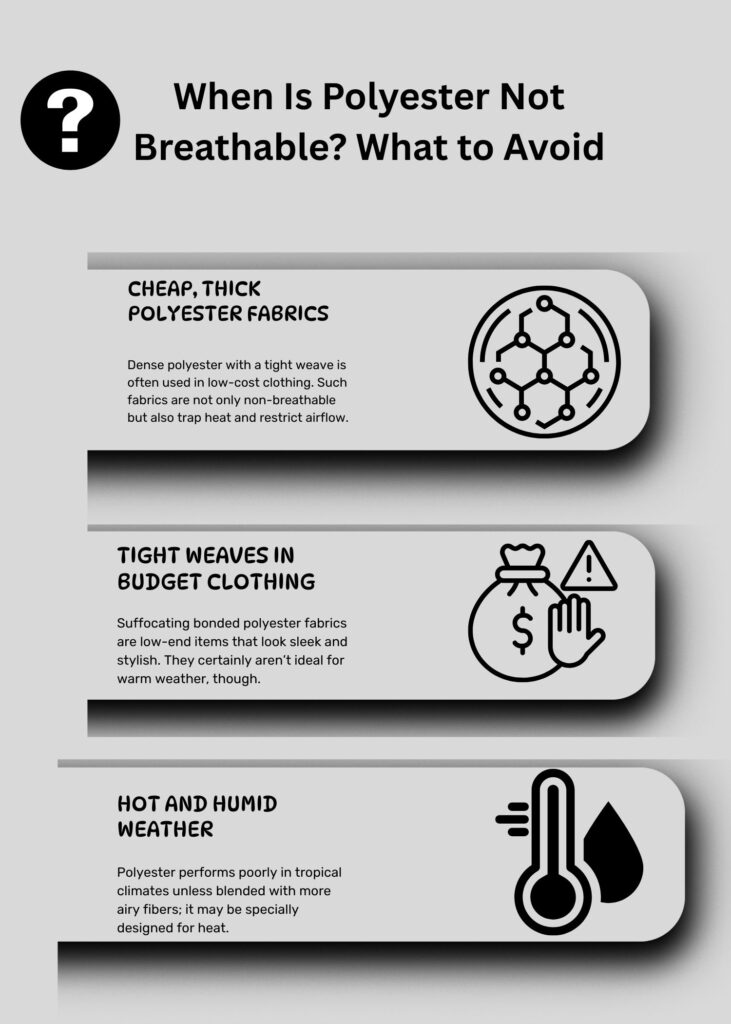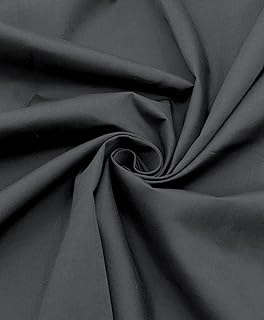Introduction
You can find polyester everywhere as it is one of the most used synthetic fabrics in the world. From casual clothing and activewear to bedsheets. It is popular in fashion and home textiles because it durable, affordable, and easy to clean.Is polyester breathable?
However, there remains one burning question: Is polyester breathable? This question matters more than most people think. Breathability greatly affects comfort levels which wearers experience when donning clothes in hot or humid weather. It affects how well air flow moves through the fabric, how well the fabric will let air flow in and out, as well as manage moisture like sweat.
Knowing how breathable polyester is will aid you in making better decisions regarding clothes for exercising, everyday activities, and opting for comfort during different seasons . In this post we’ll discuss the polyester debate about breathability including it’s optimal use and strategies for better decision making on choosing your clothing.
What Is Polyester and Why Is It So Popular?
Polyester is a type of fiber that uses oil as its main ingredient. It is made from coal, air, water, and petroleum in a chemical reaction. The fibers are spun into threads and fabric produced through weaving and knitting.
You can find polyester in numerous items such as sportswear , t-shirts , jackets , curtains and even bedsheets. These items are blanked or colorful . People like to use these products because they have many benefits like being strong , wrinkle resistant, color fast and easy to wash (practical). Polyester resists shrinking too.
In addition, polyester’s ability to pull moisture away from the body makes it popular with many manufacturers for use in performance wear. This feature comes especially handy for athletic clothing where sweat needs to be controlled.
Understanding Fabric Breathability: What Makes a Fabric Breathable?

What Does “Breathable” Mean in Fabric?
A breathable piece of clothing is one which allows vapors such as sweat and air to flow easily through it. Breathable fabrics allow fresh air to circulate in the body, enabling regulation of body temperature, helping you stay cool and comfortable.
Breathable fabrics with high levels dry faster even during exercise. They do not adhere to skin or trap heat, which why breathability is essential during warm and active conditions.
How Is Fabric Breathability Measured?
Breathability can be measured using two concepts: moisture-wicking and air permeability. Heat and physical exertion generate byproducts such as perspiration, which moisture wicking describes as a fabric’s ability to draw sweat away from the body. Air permeability refers to the degree of ventilation in a porous material, specifically how easily air flows through its structure and pores.
Hydrophilic properties tend to rely on fiber composition; weave or knit construction affects the cross-sectional shape as well with treatments applied to the fabric resulting in further variation. Breathability is variable for polyester because of these factors.
Natural vs. Synthetic Fabrics: A Quick Comparison
As cotton and linen are natural fabrics, they often provide better airflow due to their coarser fiber structure. They absorb moisture rather than wick it away. On the other hand, synthetic fibers such as polyester are intended to resist water and dry quickly, though at times their breathability can be lacking.
So, is polyester breathable compared to cotton? It depends on how the fabric is made—but if designed properly, it can be breathable as well.
Is Polyester Breathable? It Depends on Fabric Construction
The simple answer is: yes, but restructuring the question would help. A polyester fabric’s breathability is determined by its production and subsequent application.
wouldn’t require more detail than this.
Weave and Knit Type: Loose vs. Tight
Looking at the way/polyester yarn ofteh knitted or woven will definitely matter in this case. For activewear and sports apparel, looser weaves and mesh knits are dzihr vents fabrics aotkr syntheit cloak underwear Pedro. Tighter materials ends will lessen warm portion circulation while also blocking cool air, hence reducing breathability of the fabric.
Fabric Blends Matter
The positive properties of polyester are improved with natural fibers like cotton or bamboo. For instance, the polyester-cotton blend not only moisture wicks but also provides the breathable comfort of cotton. Such blended fabrics are used in T-shirts and leisure wear, as well as summer apparel.
Moisture-Wicking Technologies in Sports Polyester
Performance polyester focuses on airflow and sweat removal from the body. This includes Coolmax and Climalite which enhance flow for ventilation (cooling down) and drying time. Easy breathability characterizes these varieties of Polyester, making them suitable for athletes and active individuals.
How Polyester Compares to Other Fabrics
| Fabric | Breathability | Moisture-Wicking | Drying Speed |
| Polyester | Medium | High | Fast |
| Cotton | High | Low | Slow |
| Linen | Very High | Low | Moderate |
| Bamboo | High | Medium | Moderate |
Pros and Cons of Polyester for Breathability
Pros of Polyester
- Fast-drying: Perfect for high-aerobic activities.
- Moisture-wicking: Maintains dryness against the skin during movement.
- Lightweight: Commonly utilized in a layered system for sports apparel characteristically as outer wear.
Cons of Polyester
- Can retain heat: Particularly iffgCthe fabric used is densely woven or overly thick.
- Not as breathable than natural materials: In warmer regions, these fabrics perform poorly compared to cotton or linen.
- Can capture/sustain scent jireduce odor: Unlike cotton, it can hold on to sweat odors unabhängig.
When Is Polyester Breathable? Best Use Cases
Activewear and Sportswear
Specialty textiles of performance polyester fabrics offer venting systems such as mesh areas and engineered airflow channels that enhance breathability. Proper temperature regualtion during workouts, coupled with comfort for the athlete is essential in these fabrics.
Outdoor and Performance Gear
Jackest, hiking shirts, and even base layers are crafted from polyester ingrained with a moisture-wicking liner or mesh design aimed at capturing perspiration. These garments are made to withstand harsh environments that demand respiration and insulation at the same time.
Cooler Climates
Breathable polyester fabrics provide insulation while effectively managing perspiration. In colder climates, breathable polyester garments keep you warm without overheating or becoming clammy.
When Is Polyester Not Breathable? What to Avoid

Cheap, Thick Polyester Fabrics
Dense polyester with a tight weave is often used in low-cost clothing. Such fabrics are not only non-breathable but also trap heat and restrict airflow.
Tight Weaves in Budget Clothing
Suffocating bonded polyester fabrics are low-end items that look sleek and stylish. They certainly aren’t ideal for warm weather, though.
Polyester performs poorly in tropical climates unless blended with more airy fibers; it may be specially designed for heat. Alones in hot, humid environments, polyester textiles can lead to sweating, fatigue, and discomfort.
Hot and Humid Weather
Polyester performs poorly in tropical climates unless blended with more airy fibers; it may be specially designed for heat. Alones in hot, humid environments, polyester textiles can lead to sweating, fatigue, and discomfort.
How to Make Polyester More Breathable? Smart Clothing Tips
- Select performance polyester: Seek moisture-wicking technologies such as Dri-FIT, or zones of mesh fabric.
- Choose blended fabrics: Comfort and ventilation are provided by blends such as cotton-polyester or bamboo-polyester.
- Wear loose fits: Tight clothing restricts airflow. Breathability is enhanced in looser fitting garments made from polyester.
- Check for ventilation features: Terms like “vented,” “breathable mesh,” or “air flow panels” are your go-to.
Best Breathable Alternatives to Polyester
Natural Fabrics
- Cotton: While it breathes well, it does not wick moisture and sweat is absorbed.
- Linen: Extremely breathable and lightweight, best suited to hot climates.
- Bamboo: Soft and naturally breathable as well as antibacterial.
High-Tech Synthetics
- Merino Wool Blends: Regulates temperature while absorbing moisture.
- Tencel (Lyocell) : Absorbs moisture, is breathable, and eco-friendly.
- Coolmax: Designed for heightened breathability in polyester-based technical fabrics.
Common Myths About Polyester Breathability
“All Polyester Is Non-Breathable” – False
There are various types of polyester, each serving a unique purpose. For example, performance polyester is used for UK technical textiles while considering moisture management. Moreover, the drying capabilities of work clothing maintenance polyester outperform those of cotton.
“Cotton Is Always Better” – Not Necessarily
While nearly perfect in breathability, cotton has some downsides. Specifically, it absorbs and retains moisture making washing or slow drying. Laundering fabrics, whether through soaking and rinsing or sponge- washing should eliminate all viscous materials resulting from the cleaning process—remnants of previous soiling that make calendering effortless sandable.
FAQs on Polyester Breathability
Does polyester make you sweat more?
It can, but not always. Poorly constructed polyester can trap heat. Performance polyester, however, helps manage perspiration better than average fabrics.
Is polyester good for summer?
Yes, if it’s blended or made with breathable technology. Otherwise, natural fabric s are often better.
Which is more breathable: polyester or nylon?
Polyester is usually more breathable than nylon. The latter tends to be less airy and warmer to wear.
Can you wear polyester in humid weather?
Only if it is breathable and moisture-wicking. Blends work best while mesh versions are ideal in high temperatures.
Conclusion
Is polyester breathable? The answer is yes, but only depending on its purpose and how it’s utilized. On its own, polyester does not breath as easily as linen or cotton; however, modern textile technology has improved that. Performance grades of polyester are highly breathable, wicking moisture away during physical activity in the outdoors.
Polyester blended with other fabrics fulfills comfortable everyday clothing and durable work attire. Classic cotton shirts loose to more delicate garments such as t-shirts made from natural fiber fabrics in extremely hot weather.
Be particularly careful when choosing something for your needs: from workout shirts designed to breath easily to standard issue daily apparel. As always, check under the label for construction details and features instead of waiting to be told what the garment’s materials are.


